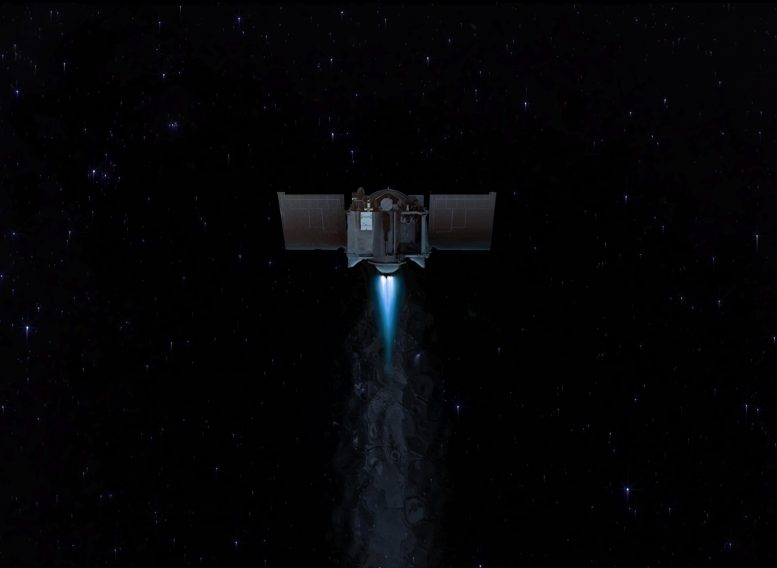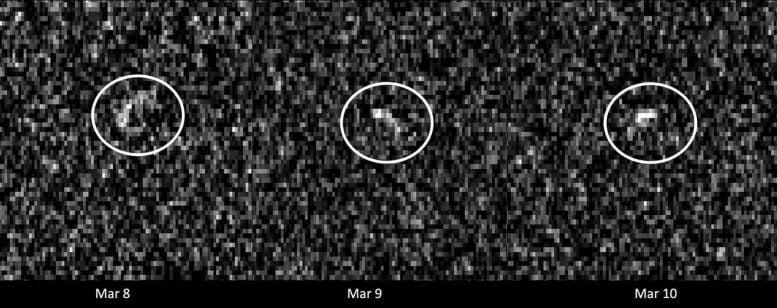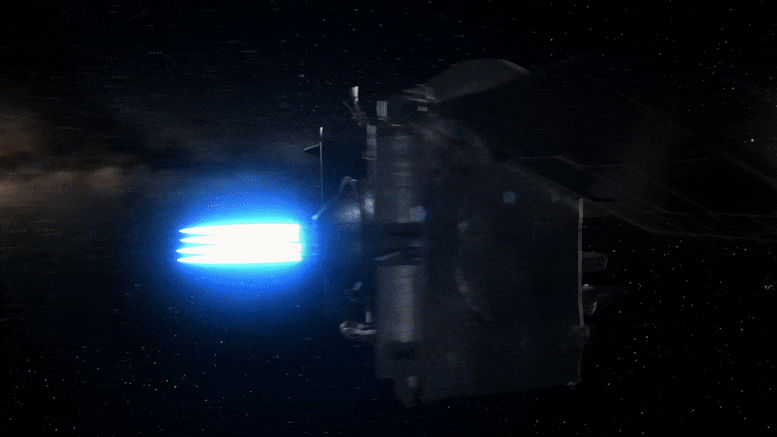by
OSIRIS-REx, now OSIRIS-APEX, is on a mission to study the asteroid Apophis, using its close approach to Earth in 2029. After successfully returning a sample from Bennu, the spacecraft will observe Apophis, an S-type asteroid, providing insights into solar system formation and planetary defense . Source: NASA Goddard Space Flight Center
the previous Osiris Rex The spacecraft will embark on a journey to study the asteroid Apophis and benefit from the asteroid's flyby of Earth in 2029, something the likes of which has not happened since the dawn of recorded history.
At the end of a long road trip, it might be time to sit back and relax for a while — especially if it's a seven-year, 4 billion-mile journey to bring a sample of the asteroid Bennu back to Earth. But OSIRIS-REx (Origins, Spectral Interpretation, Resource Identification and Security – Regolith Explorer), NASA The mission, which accomplished this feat in September, is already on its way (with a new name) to explore a new destination.
When OSIRIS-REx left Bennu in May 2021 with a sample on board, its instruments were in good condition, and it still had a quarter of its fuel remaining. So, instead of shutting down the spacecraft after delivering the sample, the team proposed sending it on an additional mission to the asteroid Apophis, with an expected arrival in April 2029. NASA, OSIRIS-APEX (Origins, Spectral Interpretation, Resource Identification, and Security – Apophis Explorer) agreed.

This illustration shows the OSIRIS-REx spacecraft leaving the asteroid Bennu to begin its two-year journey back to Earth. Image source: NASA/Goddard/University of Arizona
A rare opportunity in Apophis
After considering several perspectives (including Venus And various comets), NASA chose to send the spacecraft to Apophis, an S-type asteroid made of silicate, iron, and nickel materials — slightly different from the carbon-rich C-type asteroid Bennu.
The curiosity of Apophis lies in its exceptional close proximity to our planet on April 13, 2029. Although Apophis will not hit Earth during this encounter or in the foreseeable future, a pass in 2029 will bring the asteroid within 20,000 miles (32,000 kilometers) of Earth. Surface – Closer than some satellites, close enough that it can be seen with the naked eye in the Eastern Hemisphere.
Scientists estimate that asteroids the size of Apophis, which are about 367 yards (about 340 meters) across, approach Earth only once every 7,500 years.

These images of the asteroid Apophis were recorded by radio antennas at the Deep Space Network's Goldstone Complex in California and the Green Bank Telescope in West Virginia. The asteroid was 10.6 million miles (17 million kilometers) away, and each pixel had a resolution of 127 feet (38.75 meters). Image source: NASA/JPL-Caltech and NSF/AUI/GBO
“OSIRIS-APEX will study Apophis directly after this pass, allowing us to see how its surface changes by interacting with Earth's gravity,” said Amy Simon, the mission's project scientist based at NASA's Goddard Space Flight Center in Greenbelt, Maryland.
Apophis's close encounter with Earth will change the asteroid's orbit and the length of its 30.6-hour day. The encounter could also cause earthquakes and landslides on the asteroid's surface, potentially shifting material and revealing what lies beneath.
“Getting closer is a wonderful natural experience,” said Danny Mendoza Dellagiostina, principal investigator for OSIRIS-APEX at the University of Arizona in Tucson. “We know that tidal forces and the buildup of rubble pile material are fundamental processes that can play a role in planet formation. They can tell us how we went from debris in the early solar system to full-fledged planets.”
Apophis represents more than just an opportunity to learn more about how solar systems and planets form: in fact, most of the known potentially hazardous asteroids (those whose orbits lie within 4.6 million miles of Earth) are also S-type. What the team knows about Apophis could benefit planetary defense research, a top priority for NASA.
OSIRIS-APEX: Itinerary
By April 2, 2029 — about two weeks before Apophis approaches Earth — OSIRIS-APEX cameras will begin taking images of the asteroid as the spacecraft catches up with it. Apophis will also be closely monitored by ground-based telescopes during this time. But in the hours after the close encounter, Apophis will appear too close to the sun in the sky to be spotted by ground-based optical telescopes. This means that any changes caused by the close encounter will be better detected by the spacecraft.
This animation depicts the orbital path of asteroid 99942 Apophis as it safely passes near Earth on April 13, 2029. Earth's gravity will skew the path slightly as the 1,100-foot-wide (340-meter) near-Earth object approaches from a distance of 20,000 meters. mile (32,000 km) from the surface of our planet. The dots are the many man-made satellites orbiting our planet. The movement was sped up 2000 times. Credit: NASA/Jet Propulsion Laboratory-California Institute of Technology
OSIRIS-APEX will arrive at the asteroid on April 13, 2029, and will operate near it for about 18 months. In addition to studying changes to Apophis as a result of its collision with Earth, the spacecraft will conduct many of the same investigations that OSIRIS-REx conducted on Bennu, including using its instrument suite of imagers, spectrometers, and laser altimeters to map and closely analyze the surface. Its chemical composition.
As a debut, OSIRIS-APEX will reenact one of OSIRIS-REx's most impressive feats (without sample collection), diving 16 feet from the asteroid's surface and firing its thrusters downward. This maneuver will stir up surface rocks and dust to give scientists a peek at the material below.
Although the rendezvous with Apophis is still more than five years away, the next milestone in his journey is… The first sun out of six passes close. These close approaches, along with three gravitational assists from Earth, will put OSIRIS-APEX on track to reach Apophis in April 2029.
What OSIRIS-APEX will discover about Apophis remains to be seen, but if previous incarnations of the mission are any indication, surprising science lies ahead. “We learned a lot on Benue, but now we are armed with even more questions about our next target,” Simon said.
NASA's Goddard Space Flight Center provides comprehensive mission management, systems engineering, safety, and mission assurance for OSIRIS-APEX. Danny Mendoza della Giustina of the University of Arizona, Tucson, is the principal investigator. The university leads the science team and plans scientific monitoring and data processing for the mission. Lockheed Martin Space in Littleton, Colorado, built the spacecraft and provides flight operations. Goddard and KinetX Aerospace are responsible for navigation of the OSIRIS-APEX spacecraft. International partnerships on this mission include the spacecraft's laser altimeter instrument from the Canadian Space Agency (Canadian Space Agency) and scientific collaborations with JAXAHayabusa 2 mission (Japan Aerospace Exploration Agency). OSIRIS-APEX (formerly OSIRIS-REx) is the third mission in NASA's New Frontiers Program, which is managed by NASA's Marshall Space Flight Center in Huntsville, Alabama, for the agency's Science Mission Directorate in Washington.

“Extreme travel lover. Bacon fanatic. Troublemaker. Introvert. Passionate music fanatic.”








More Stories
A fossilized creature may explain a puzzling drawing on a rock wall.
MrBeast Sued Over ‘Unsafe Environment’ on Upcoming Amazon Reality Show | US TV
Watch comets Lemmon and SWAN approach Earth today